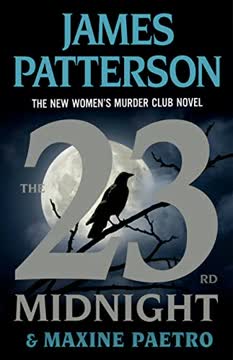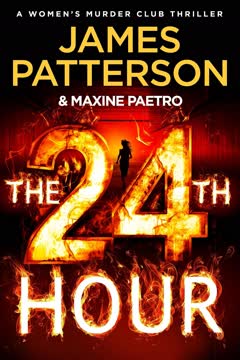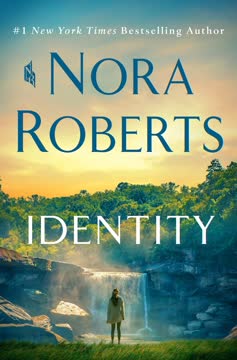Plot Summary
Dawn of Blackout
In the predawn gloom of San Francisco, a man in black—soon known as "Blackout"—meticulously stalks and kills a young mother, Catherine Fleet, and her infant daughter, Josie. The killer's calculated violence, use of pepper spray, and cold efficiency are immediately apparent. A jogger stumbles upon the scene and is also murdered, establishing Blackout's ruthlessness and his ability to improvise. The killer's actions are not random; he is creating a "masterwork," inspired by a notorious serial killer, Evan Burke, who is now imprisoned. This opening sequence sets the tone for a city under siege by a new, intelligent, and remorseless predator.
Cindy's Deadly Spotlight
Cindy Thomas, crime reporter and member of the Women's Murder Club, is on a book tour promoting her biography of Evan Burke. The book's success brings her into the public eye, but also into the crosshairs of a killer obsessed with Burke's legacy. Cindy's immersion in Burke's psyche has left her vulnerable and changed, haunted by the darkness she's chronicled. Her public appearances become focal points for both adulation and danger, as she is confronted by hecklers and stalked by unseen threats. Cindy's personal and professional lives blur, and her friends grow increasingly concerned for her safety.
The Book That Haunts
Cindy's book, "You Never Knew Me," is more than a bestseller—it's a catalyst. The biography, based on interviews with Burke, details his crimes and methods, and becomes a blueprint for Blackout's own spree. The killer is both a fan and a competitor, seeking to outdo his idol. Cindy's relationship with Burke, and her access to his inner thoughts, make her both a target and a potential key to stopping the new murders. The book's influence ripples outward, ensnaring not just Cindy but the entire Women's Murder Club in a deadly game of imitation and escalation.
A Killer's Homage
Blackout's murders are not just random acts of violence; they are carefully staged tributes to Burke's most infamous crimes. He films his killings with video glasses, adding classical music and artistic flourishes, then sends the footage to Sergeant Lindsay Boxer, taunting her and the police. Each murder is both a message and a challenge, designed to evoke Burke's style while demonstrating Blackout's own superiority. The killer's need for recognition and his obsession with legacy drive him to ever more elaborate and public acts, escalating the threat to the city and to Cindy herself.
Murder at the Bookstore
During a book signing, Cindy is heckled by a man named Ralph Hammer, who accuses her of glorifying killers. Shortly after, Hammer is found murdered in his car, killed in a manner reminiscent of Blackout's other victims. The murder is captured on video and sent to Lindsay, confirming that the killer is targeting those connected to Cindy's book events. The Women's Murder Club realizes that the killer is using Cindy's tour as a hunting ground, and that anyone who crosses paths with her could be next. The sense of danger intensifies, and the investigation becomes personal.
The Women's Murder Club Rallies
Lindsay Boxer, Yuki Castellano, Claire Washburn, and Cindy Thomas—each an expert in her field—band together to confront the escalating crisis. Their camaraderie and mutual support are tested as the murders hit closer to home. Lindsay leads the police investigation, Yuki prosecutes a parallel domestic violence case, Claire provides forensic expertise, and Cindy struggles with her own trauma and guilt. The Club's meetings become strategy sessions, blending friendship with professional resolve. As the killer's pattern emerges, the women realize that only by working together can they hope to stop him.
The Heckler's Fate
The man who heckled Cindy at her book event, Ralph Hammer, is murdered in a manner that mirrors Blackout's signature style. The killing is filmed and sent to the police, further cementing the connection between Cindy's public appearances and the killer's actions. The murder serves as both a warning and a provocation, pushing the Women's Murder Club to intensify their efforts. The killer's ability to blend into crowds and strike at will creates an atmosphere of paranoia and fear, as anyone associated with Cindy or the book could be a potential target.
Copycat in the Shadows
Blackout is revealed to be a highly intelligent, disciplined, and creative killer, drawing inspiration from Burke's crimes but adding his own technological and psychological twists. He uses video glasses to document his murders, edits the footage with music and commentary, and sends it directly to Lindsay as a form of psychological warfare. The police struggle to identify him, as he leaves no forensic evidence and seems to anticipate their every move. The killer's obsession with legacy and recognition drives him to ever more audacious acts, including the abduction of Cindy.
The Fleet Family Tragedy
The murder of Catherine and Josie Fleet shocks the city and devastates their husband and father, Brad Fleet. The killings are a direct homage to one of Burke's most notorious crimes, signaling that Blackout is not just copying but escalating. The Women's Murder Club is drawn into the investigation, piecing together the connections between the victims, the killer, and Cindy's book. The emotional toll of the case weighs heavily on the team, as they confront the reality that the killer is always one step ahead.
Videos of Death
Blackout's use of video glasses transforms his killings into cinematic events, complete with soundtracks and commentary. He sends the videos to Lindsay, taunting her and the police with his artistry and control. The footage provides both clues and psychological torment, as the investigators are forced to watch the murders unfold from the killer's perspective. The videos become a central plot device, driving the investigation and deepening the sense of dread. The killer's need for an audience—and for Lindsay's attention—becomes increasingly apparent.
Cat and Mouse
As the Women's Murder Club and the police close in on Blackout, he responds by raising the stakes. He abducts Cindy, making her the centerpiece of his deadly game. The search for Cindy becomes a race against time, as the killer sends videos of her captivity and issues demands for the release of Burke. The investigation uncovers Blackout's military background, his history of violence, and his correspondence with Burke. The tension reaches a breaking point as the team must use all their skills and resources to save their friend.
The Sullivan Case
Interwoven with the main plot is the trial of Lewis Sullivan, a man accused of the brutal attempted murder of his wife, Barbara. Yuki prosecutes the case, which serves as a thematic counterpoint to the main story. The trial explores issues of domestic violence, victimhood, and the limits of justice. Barbara's testimony and ultimate fate mirror the struggles of the Women's Murder Club, highlighting the pervasive nature of violence and the resilience required to confront it. The case also becomes a target for Blackout, who leaves his mark in a shocking twist.
Blackout's Signature
The investigation finally uncovers Blackout's true identity: Bryan Catton, a former Marine with a history of violence and a genius-level intellect. His obsession with Burke, his use of technology, and his need for recognition are laid bare. The team discovers his lair, his hit list, and his correspondence with Burke, revealing a chilling partnership between the two killers. The final confrontation is a desperate struggle, as Lindsay and Rich risk their lives to capture Catton and rescue Cindy. The resolution is hard-won, but the scars remain.
Cindy in Peril
Cindy's abduction and near-death experience are the emotional climax of the novel. Trapped, suffocating, and on the brink of death, she is rescued at the last moment by her friends and the police. The ordeal leaves her physically and emotionally shattered, but also reaffirms the strength of the Women's Murder Club. The rescue is a testament to the power of friendship, determination, and teamwork in the face of evil.
The Final Hunt
With Catton in custody and Burke exposed as his mentor and co-conspirator, the Women's Murder Club reflects on the cost of their victory. The legal system grinds forward, with Catton facing multiple murder charges and Burke stripped of his privileges. The team grapples with trauma, guilt, and the lingering threat of violence, but also finds solace in each other and in small moments of normalcy. The novel ends on a note of hard-won hope, as the women look to the future, changed but unbroken.
Burke's Deadly Influence
Evan Burke's role as Blackout's inspiration and advisor is revealed through letters, prison visits, and the killer's own confessions. Burke's manipulation extends beyond the grave, as he orchestrates murders from his cell and seeks to cement his legacy through Catton's crimes. The relationship between the two killers is a study in narcissism, control, and the dark allure of infamy. The Women's Murder Club must confront not just a killer, but the seductive power of evil itself.
The Trap Closes
The capture of Blackout and the rescue of Cindy bring a measure of closure to the city and to the Women's Murder Club. The team's resilience, resourcefulness, and unwavering support for each other are celebrated, even as they acknowledge the lasting impact of the trauma they've endured. The novel ends with a sense of cautious optimism, as the women prepare to face whatever challenges come next—together.
Characters
Lindsay Boxer
Lindsay is the heart of the Women's Murder Club and the lead investigator on the Blackout case. Her determination, intelligence, and empathy drive the investigation forward, even as she grapples with personal fears and the trauma of witnessing so much violence. Lindsay's relationships—with her husband Joe, her daughter Julie, and her friends—ground her, but also make her vulnerable. She is haunted by the killer's taunts and the danger to her loved ones, but never loses sight of her duty. Lindsay's arc is one of resilience, leadership, and the struggle to balance justice with self-care.
Cindy Thomas
Cindy's role as the author of Burke's biography places her at the center of the storm. She is both a chronicler of evil and a victim of its consequences. Cindy's journey is one of survival—first from the psychological toll of her work, then from the physical threat posed by Blackout. Her abduction and rescue are the emotional core of the novel, highlighting her vulnerability but also her courage. Cindy's relationships with the other women, especially Lindsay and Rich, provide her with strength and a path to healing.
Yuki Castellano
Yuki's parallel prosecution of the Sullivan case adds depth and thematic resonance to the novel. She is a fierce advocate for justice, unafraid to confront difficult truths and challenge the system. Yuki's empathy for victims and her commitment to the law are tested by the brutality of the cases she handles. Her personal struggles with self-doubt and the emotional toll of her work mirror those of her friends, reinforcing the novel's exploration of trauma and resilience.
Claire Washburn
Claire provides forensic expertise and emotional support to the team. Her ability to find humanity in the midst of horror is a source of comfort for her friends and a counterbalance to the darkness they face. Claire's role as a mother and her deep empathy for victims, especially children, underscore the stakes of the investigation. She is a steadying presence, offering both scientific insight and personal wisdom.
Rich Conklin
Rich is Lindsay's partner on the force and Cindy's partner in life. His loyalty, bravery, and quick thinking are instrumental in the investigation and in Cindy's rescue. Rich's emotional journey—from professional detachment to personal desperation—reflects the novel's themes of vulnerability and the limits of control. His willingness to risk everything for those he loves cements his place as a core member of the Club's extended family.
Blackout (Bryan Catton)
Blackout is a chilling antagonist: intelligent, disciplined, and driven by a need for recognition. His crimes are both homage and competition, as he seeks to surpass his idol, Evan Burke. Blackout's use of technology, his artistic flourishes, and his psychological warfare make him a formidable foe. His military background and history of violence are revealed gradually, painting a portrait of a man shaped by trauma, ego, and a desire for legacy. His ultimate downfall is a testament to the power of collective action and the limits of individual genius.
Evan Burke
Burke's influence pervades the novel, even from his prison cell. His correspondence with Blackout, his manipulation of Cindy, and his orchestration of murders from afar make him a shadowy puppet master. Burke's narcissism, intelligence, and lack of remorse are both fascinating and terrifying. He represents the seductive power of evil and the dangers of glorifying killers. Burke's relationship with Blackout is a study in control, legacy, and the dark allure of infamy.
Barbara Sullivan
Barbara's story, told through the parallel trial, is a powerful exploration of domestic violence and the limits of justice. Her testimony, suffering, and ultimate fate mirror the struggles of the Women's Murder Club. Barbara's courage in the face of unimaginable pain is both inspiring and heartbreaking. Her murder by Blackout serves as a grim reminder of the pervasive nature of violence and the need for vigilance and support.
Jackson Brady
Brady is the lieutenant overseeing the investigation, providing guidance, support, and tough love to the team. His experience, calm under pressure, and willingness to make hard decisions are crucial to the case's resolution. Brady's relationships with the women, especially Yuki, add depth and humanity to his character. He is a model of leadership in crisis.
Joe Molinari
Joe is Lindsay's husband and a former FBI agent. His expertise, emotional intelligence, and unwavering support provide Lindsay with a safe harbor amid the storm. Joe's role as a father and partner highlights the importance of family and self-care in the face of trauma. His insights and actions are instrumental in the investigation and in Lindsay's personal journey.
Plot Devices
Copycat Serial Killer
The central plot device is the emergence of Blackout, a serial killer who models his crimes on those of Evan Burke. This device allows for an exploration of the psychology of imitation, the dangers of glorifying killers, and the ripple effects of violence. Blackout's need to surpass his mentor drives the escalation of the murders and the complexity of the investigation.
Murder as Performance
Blackout's use of video glasses to film his murders, edit them with music, and send them to the police transforms the killings into performance art. This device heightens the psychological stakes, as the investigators are forced to witness the crimes from the killer's perspective. The videos serve as both clues and taunts, deepening the sense of dread and urgency.
Parallel Narratives
The novel weaves together the main investigation with the trial of Lewis Sullivan, creating a thematic resonance between public and private violence. The parallel narratives allow for an exploration of justice, victimhood, and the limits of the legal system. The Sullivan case serves as both a counterpoint and a mirror to the main plot, reinforcing the novel's central concerns.
Psychological Warfare
Blackout's correspondence, videos, and personal attacks on the Women's Murder Club are designed to destabilize and torment his pursuers. The use of psychological warfare as a plot device raises the stakes and personalizes the conflict, making the investigation as much about survival and resilience as about solving the case.
Mentor and Protégé
The relationship between Burke and Blackout is a study in manipulation, legacy, and the dangers of unchecked influence. Burke's role as a mentor, even from behind bars, adds a layer of complexity to the investigation and raises questions about responsibility, complicity, and the seductive power of evil.
Race Against Time
The abduction of Cindy transforms the investigation into a desperate race against time. The ticking clock, the killer's demands, and the team's emotional investment create a sense of urgency and suspense that drives the narrative to its climax.
Analysis
"The 23rd Midnight" is more than a procedural thriller; it is a meditation on the ways violence echoes through lives, institutions, and culture. By centering the story on a copycat killer inspired by a notorious predecessor, the novel interrogates the dangers of glorifying evil and the seductive power of infamy. The Women's Murder Club, with their blend of expertise, friendship, and vulnerability, serve as both investigators and survivors, embodying the resilience required to confront trauma and injustice. The novel's use of technology, psychological warfare, and parallel narratives reflects the complexities of modern crime and the challenges of seeking justice in a world where evil is both celebrated and imitated. Ultimately, the book is a testament to the power of collective action, the importance of empathy, and the necessity of confronting darkness with courage and hope.
Last updated:
Review Summary
The 23rd Midnight receives mostly positive reviews, with readers praising its fast-paced plot, engaging characters, and thrilling storyline. Many fans enjoy the Women's Murder Club series and find this installment compelling. Some criticize predictability and repetitiveness, while others appreciate the character development and multiple plot threads. The book features Detective Lindsay Boxer hunting a copycat killer, Cindy Thomas on a book tour, and Yuki Castellano prosecuting a domestic abuse case. Overall, readers find it an entertaining addition to the series, though opinions vary on its quality compared to earlier books.
Women's Murder Club Series Series
Similar Books
Download PDF
Download EPUB
.epub digital book format is ideal for reading ebooks on phones, tablets, and e-readers.

























